





Visit also the main downy mildew information page, & how to spot downy mildew on leaves
Here we look at the signs and progress of DM (Peronospora sp.) through plants. Also visit photos over time of plants affected by DM. Note, this is such a new disease that it has not yet been named. It is a species in the Peronospora genus (rather than being a Bremia or Plasmopara downy mildew.)
Aquilegia Downy Mildewed Plants |
||
| This aquilegia in a pot looks extremely sickly, just compare it to part of the one you can see next to it. |
|
|
| Looking closer we see something has been eating the shoots at soil level. Easing the plant from its pot, four small slugs were seen, circumstantial evidence points to these slugs as being the culprits who ate the shoots. However, this was damage secondary to infection with downy mildew as slugs would usually steer well clear of eating aquilegia tissue due to its poisonous nature: it is the fungal tissue that is drawing it here. |
|
|
| Teasing the (slug-ridden) soil from the roots, they look amazingly prolific and healthy compared to the sickly, poor top growth. There is some evidence that downy mildew may affect root tissue, but it would be unusual to do so, and top growth would then likely be affected (if not showing signs of DM itself) by stunting or wilting effects. |
|
|
| Here's another potted aquilegia, can you see distorted 'kinky' stems in the large photo? The close up shows a totally affected shoot. |
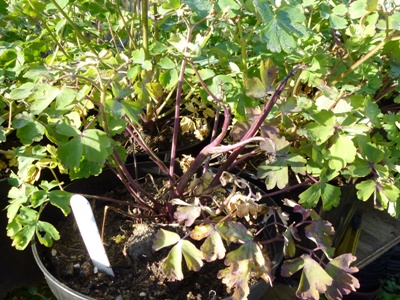 |
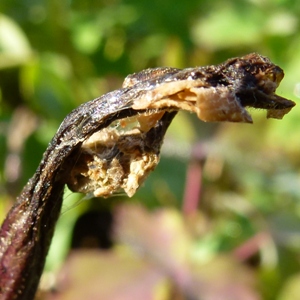 |
|
Eventually all top growth looks, and is, dead. This dead growth can be pulled away from the roots. Be careful, handling and disposing of this debris, it is likely to be full of resistant DM spores. ....as is the soil around the dead plant. |
|
|
|
Interestingly, the root is left looking intact and still plump.
To get to this stage, every leaf (including new ones) has been
infected and decayed back (see the last leaf-stems far right).
Has the root been infected? It is not known, but usually doesn't
show signs of decay, it will now takes quite some weeks/months
for this vegetative structure to disintegrate, with death due to
starvation because there is no photosynthesizing tissue. Dig it out, and be aware surrounding soil will have DM spores in it. |
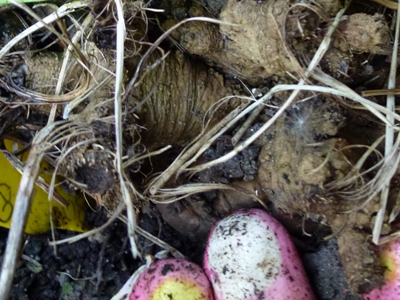 |
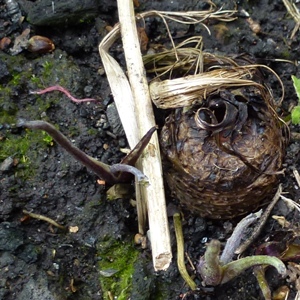 |
| Let's see a specific example: | ||
| Here's two plants of Aquilegia Spring Magic blue-&-white, showing how deformed the infected foliage is on the one top left versus the healthy bottom ring plant. The far right photo shows a close-up of the infected plant. |
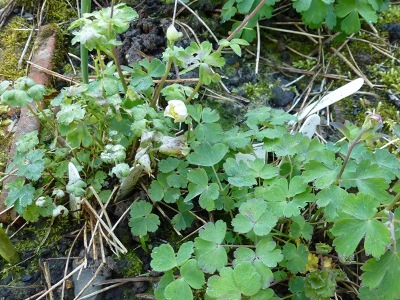 |
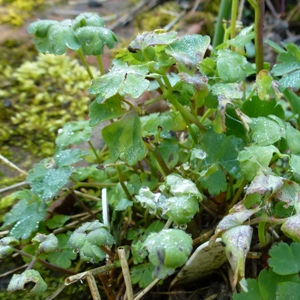 |
| Let's look closer. An extremely bedraggled looking leaf, hard to see what's killing this, until you look on the lower left of the image and see some distinctively yellow-mottled areas. The photo far right shows another leaf in an earlier stage of infection. |
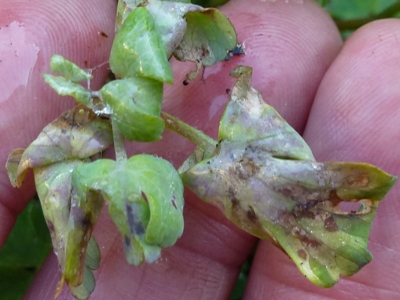 |
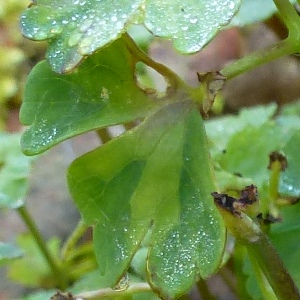 |
| There's also systemic infection, these leaves start
infected as they are produced. Rather than yellowy patches, they are
lighter green, with particularly long leafstems to leaf area.
Here they show distinctive leaf curl, in this plant it is a
downwards curl (giving a domed effect) in other plants it can be
an upwards curling. I dug out the plant, replaced it, mulched the new one frequently with grass clippings and the new plant survived this summer (2014). I will have to wait and see what happens longer term in this bed. |
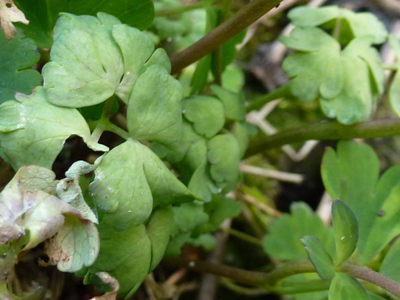 |
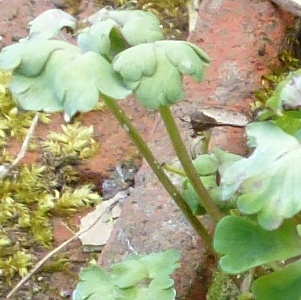 |
| Let's follow the course of the disease over 12 days in
this plant. I didn't take quicker action mainly because
at that time I had no idea how virulent and destructive the
disease would be. We will look at 3 parts of the same plant, please ignore aberrant colour cast changes over the three successional photos. My apologies for the poor quality of these pics, I didn't know what I'd be doing with the images. |
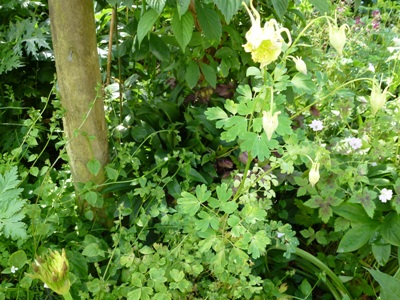 |
|
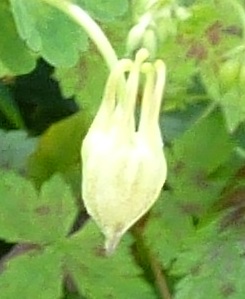 |
|
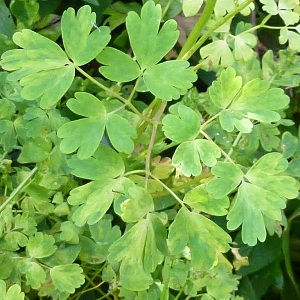 |
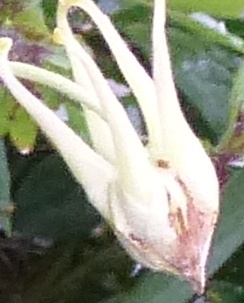 |
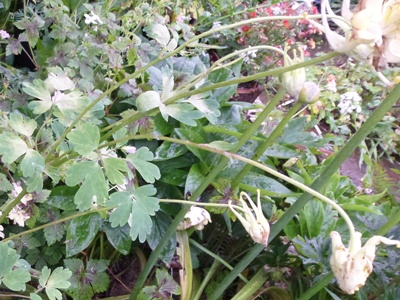 |
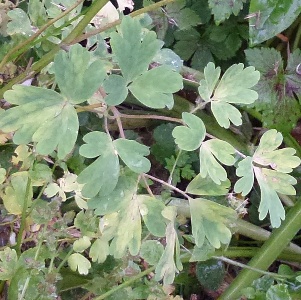 |
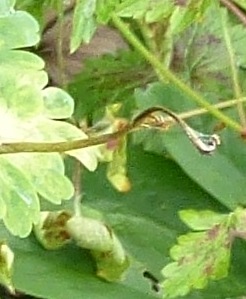 |
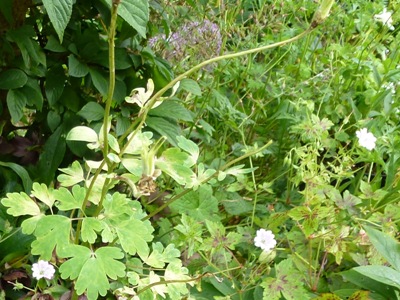 |
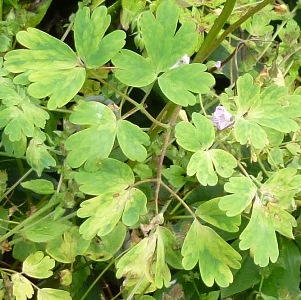 |
After 5 days a bud becomes definitely infected. Another 7 days later it had aborted, and disintegrated, with die-back infection along its stalk. |
To summarise the images above: The stem (cauline) leaves may show an increase in the infected lighter areas (it is hard to be definite). No doubt there has been increasing sporulation from the under surface of these leaves. In the set of 3 images of a particular leaf, far right, you can see the start of a few areas of slight browning and dieback on some leaflets. I finally then cut back the whole of the top growth, later removing the plant as it showed systemic infection. |
|
Visit also the main downy mildew information page, & how to spot downy mildew on leaves
| Back to top |
Copyright Carrie Thomas 2014. Web wizardry by Trevor Rees. All rights reserved.